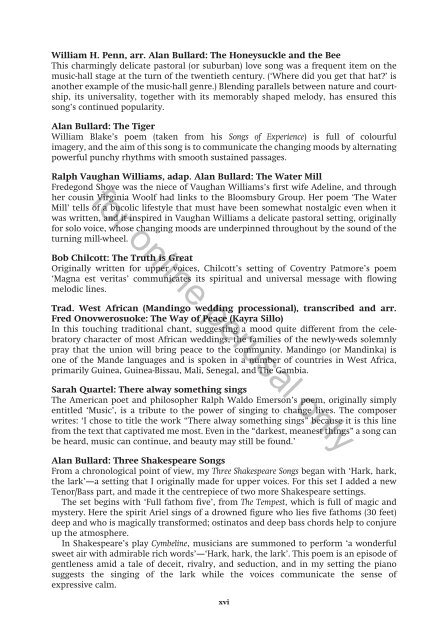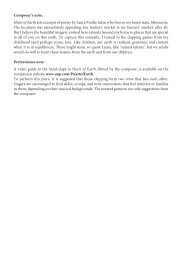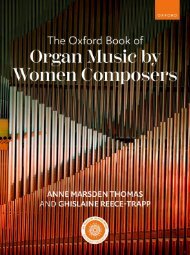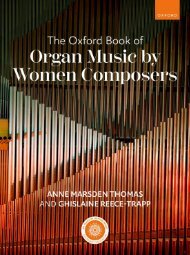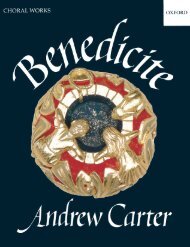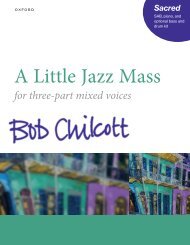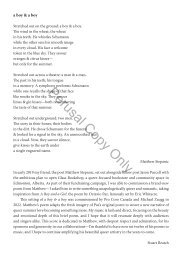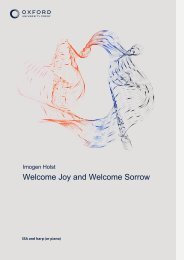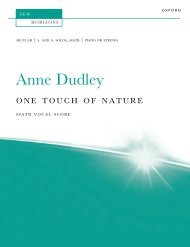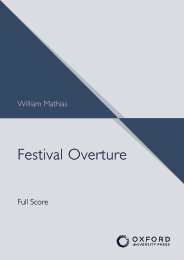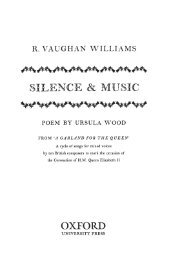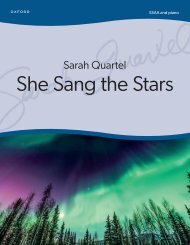Oxford Book of Flexible Choral Songs
The Oxford Book of Flexible Choral Songs is the perfect resource for secular choirs and singing groups who like the flexibility to perform songs in a range of combinations from unison to SATB. Each piece may be performed by a mixed choir, but is also presented with flexible scoring options, clearly explained throughout, enabling performance by various combinations of singers, including upper voices or men's voices alone. As well as new arrangements of existing repertoire, the collection also features newly commissioned original works, specially written for flexible forces.
The Oxford Book of Flexible Choral Songs is the perfect resource for secular choirs and singing groups who like the flexibility to perform songs in a range of combinations from unison to SATB. Each piece may be performed by a mixed choir, but is also presented with flexible scoring options, clearly explained throughout, enabling performance by various combinations of singers, including upper voices or men's voices alone. As well as new arrangements of existing repertoire, the collection also features newly commissioned original works, specially written for flexible forces.
You also want an ePaper? Increase the reach of your titles
YUMPU automatically turns print PDFs into web optimized ePapers that Google loves.
William H. Penn, arr. Alan Bullard: The Honeysuckle and the Bee<br />
This charmingly delicate pastoral (or suburban) love song was a frequent item on the<br />
music-hall stage at the turn <strong>of</strong> the twentieth century. (‘Where did you get that hat?’ is<br />
another example <strong>of</strong> the music-hall genre.) Blending parallels between nature and courtship,<br />
its universality, together with its memorably shaped melody, has ensured this<br />
song’s continued popularity.<br />
Alan Bullard: The Tiger<br />
William Blake’s poem (taken from his <strong>Songs</strong> <strong>of</strong> Experience) is full <strong>of</strong> colourful<br />
imagery, and the aim <strong>of</strong> this song is to communicate the changing moods by alternating<br />
powerful punchy rhythms with smooth sustained passages.<br />
Ralph Vaughan Williams, adap. Alan Bullard: The Water Mill<br />
Fredegond Shove was the niece <strong>of</strong> Vaughan Williams’s first wife Adeline, and through<br />
her cousin Virginia Woolf had links to the Bloomsbury Group. Her poem ‘The Water<br />
Mill’ tells <strong>of</strong> a bucolic lifestyle that must have been somewhat nostalgic even when it<br />
was written, and it inspired in Vaughan Williams a delicate pastoral setting, originally<br />
for solo voice, whose changing moods are underpinned throughout by the sound <strong>of</strong> the<br />
turning mill-wheel.<br />
for online perusal only<br />
Bob Chilcott: The Truth is Great<br />
Originally written for upper voices, Chilcott’s setting <strong>of</strong> Coventry Patmore’s poem<br />
‘Magna est veritas’ communicates its spiritual and universal message with flowing<br />
melodic lines.<br />
Trad. West African (Mandingo wedding processional), transcribed and arr.<br />
Fred Onovwerosuoke: The Way <strong>of</strong> Peace (Kayra Sillo)<br />
In this touching traditional chant, suggesting a mood quite different from the celebratory<br />
character <strong>of</strong> most African weddings, the families <strong>of</strong> the newly-weds solemnly<br />
pray that the union will bring peace to the community. Mandingo (or Mandinka) is<br />
one <strong>of</strong> the Mande languages and is spoken in a number <strong>of</strong> countries in West Africa,<br />
primarily Guinea, Guinea-Bissau, Mali, Senegal, and The Gambia.<br />
Sarah Quartel: There alway something sings<br />
The American poet and philosopher Ralph Waldo Emerson’s poem, originally simply<br />
entitled ‘Music’, is a tribute to the power <strong>of</strong> singing to change lives. The composer<br />
writes: ‘I chose to title the work “There alway something sings” because it is this line<br />
from the text that captivated me most. Even in the “darkest, meanest things” a song can<br />
be heard, music can continue, and beauty may still be found.’<br />
Alan Bullard: Three Shakespeare <strong>Songs</strong><br />
From a chronological point <strong>of</strong> view, my Three Shakespeare <strong>Songs</strong> began with ‘Hark, hark,<br />
the lark’—a setting that I originally made for upper voices. For this set I added a new<br />
Tenor/Bass part, and made it the centrepiece <strong>of</strong> two more Shakespeare settings.<br />
The set begins with ‘Full fathom five’, from The Tempest, which is full <strong>of</strong> magic and<br />
mystery. Here the spirit Ariel sings <strong>of</strong> a drowned figure who lies five fathoms (30 feet)<br />
deep and who is magically transformed; ostinatos and deep bass chords help to conjure<br />
up the atmosphere.<br />
In Shakespeare’s play Cymbeline, musicians are summoned to perform ‘a wonderful<br />
sweet air with admirable rich words’—‘Hark, hark, the lark’. This poem is an episode <strong>of</strong><br />
gentleness amid a tale <strong>of</strong> deceit, rivalry, and seduction, and in my setting the piano<br />
suggests the singing <strong>of</strong> the lark while the voices communicate the sense <strong>of</strong><br />
expressive calm.<br />
xvi


